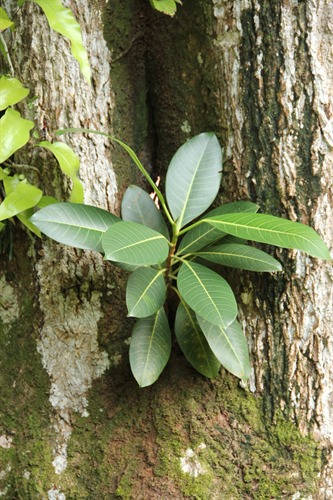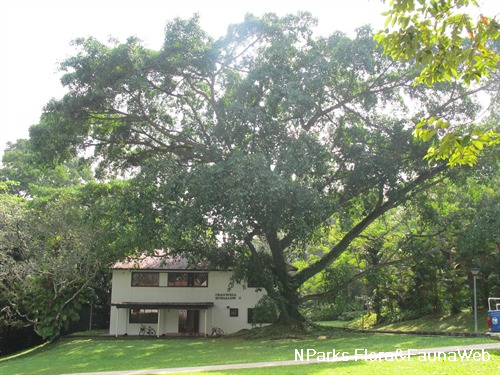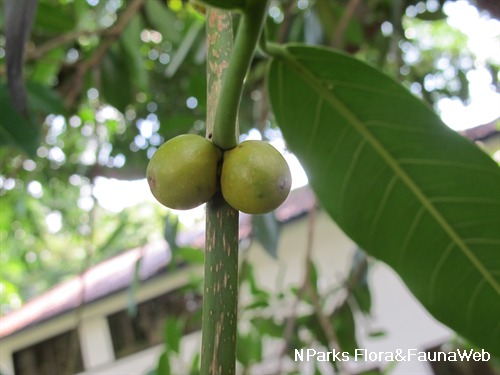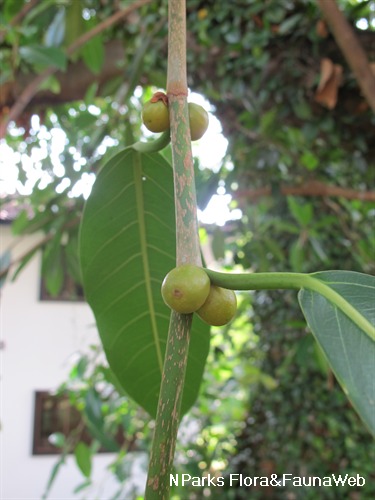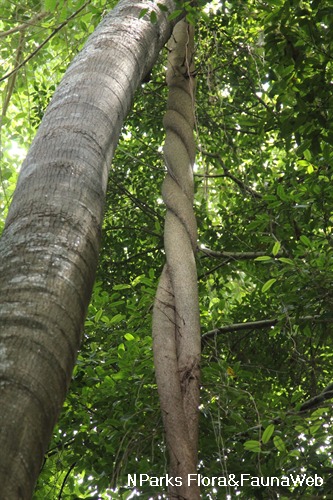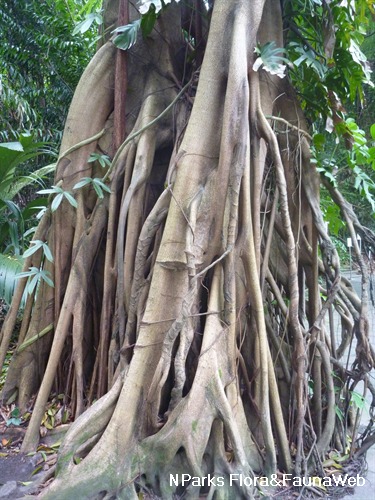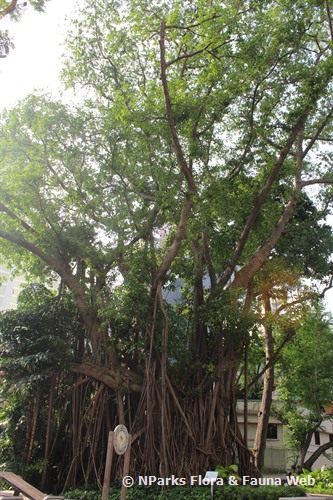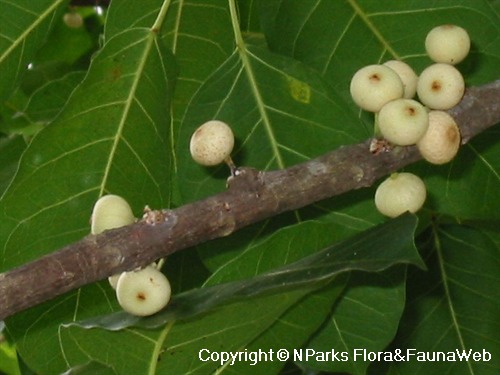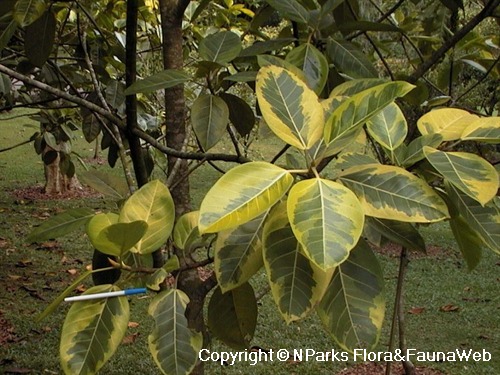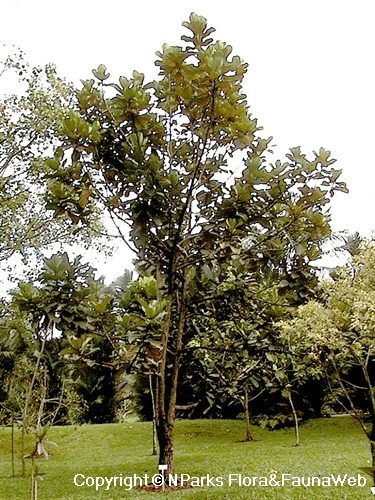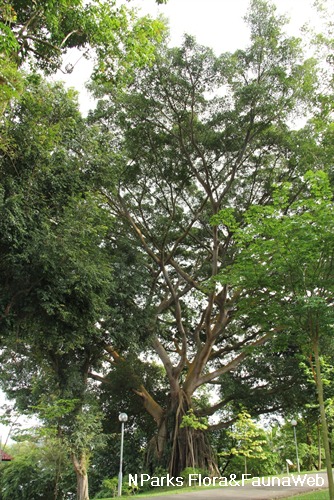
Name
Classifications and Characteristics
| Plant Division | Angiosperms (Flowering Seed Plants) (Dicotyledon) |
|---|---|
| Plant Growth Form | Tree (Big (>30m)) |
| Lifespan (in Singapore) | Perennial |
| Mode of Nutrition | Autotrophic |
| Plant Shape | Umbrella, Broad / Mushroom / Hemispherical |
Biogeography
| Native Distribution | Peninsular Malaysia, Singapore, Borneo, the Philippines, Sumatra and Java |
|---|---|
| Native Habitat | Terrestrial (Primary Rainforest) |
| Preferred Climate Zone | Tropical |
| Local Conservation Status | Native to Singapore (Endangered (EN)) |
Description and Ethnobotany
| Growth Form | It is a latex-containing, strangling fig up to 45 m tall. |
|---|---|
| Crown | Broad and spreading. |
| Foliage | Its spirally arranged, stalked leaves have thickly leathery leaf blades that are oblong to partially egg-shaped, glossy dark green, and 6–20 by 2–8 cm. It has characteristic creamy white midribs and veins. |
| Flowers | The plant is monoecious. Its male, female and gall flowers are found within the same syconium (fig). The flowers are tiny and develop within the syconium (fig). |
| Fruit | Its syconia (figs) are somewhat round, smooth, yellow to bright orange or red at maturity, 1–1.5 cm across, and usually occur in pairs or are solitary at the leaf axils. |
| Habitat | It grows in lowland and montane forests. It occurs locally in Pulau Ubin, Changi, and in the vicinity of Upper Seletar Reservoir. |
| Associated Fauna | The flowers are pollinated by fig wasps. The ripe syconia (figs) are eaten by frugivorous birds and mammals. |
| Cultivation | It can be propagated by seed, stem cutting and air-layering. |
| Etymology | The genus FicusFicus carica). The specific epithet kerkhovenii is named in honour of E. J. Kerkhoven (1834–1905), a Dutch botanist who explored Java. |
| Ethnobotanical Uses | Cultural / Religious: Heritage Tree: There are 8 individuals of Ficus kerkhovenii listed as Heritage Trees in Singapore. They are found mainly in the eastern part of Singapore, Singapore Botanic Gardens and Sentosa. To find out more about these trees, please visit the Heritage Tree Register. |
Landscaping Features
| Landscaping | It may be suitable for parks, coastal regions and roadsides. |
|---|---|
| Desirable Plant Features | Ornamental Foliage, Ornamental Fruits |
| Landscape Uses | General, Suitable for Roadsides, Parks & Gardens, Coastal |
Fauna, Pollination and Dispersal
| Fauna Pollination Dispersal Associated Fauna | Bird-Attracting (Fruits) |
|---|---|
| Pollination Method(s) | Biotic (Fauna) |
| Seed or Spore Dispersal | Biotic (Fauna) (Vertebrates (Bat), Vertebrates (Other Mammal)) |
Plant Care and Propagation
| Light Preference | Full Sun, Semi-Shade |
|---|---|
| Water Preference | Moderate Water |
| Plant Growth Rate | Moderate |
| Rootzone Tolerance | Moist Soils, Well-Drained Soils, Saline Soils / Salt Spray |
| Propagation Method | Seed, Stem Cutting, Air-Layering |
Foliar
| Foliage Retention | Evergreen |
|---|---|
| Mature Foliage Colour(s) | Green |
| Mature Foliage Texture(s) | Leathery |
| Foliar Type | Simple / Unifoliate |
| Foliar Arrangement Along Stem | Alternate |
| Foliar Attachment to Stem | Petiolate |
| Foliar Shape(s) | Non-Palm Foliage (Elliptical, Oblong) |
| Foliar Venation | Pinnate / Net |
| Foliar Margin | Entire |
| Foliar Apex - Tip | Acute |
| Foliar Base | Acute |
Non - Foliar and Storage
| Branch Angle (wrt vertical) | Acute, Horizontal Ascending |
|---|---|
| Trunk Type (Non Palm) | Woody |
| Root Type | Underground, Aboveground (Strangling Root) |
Floral (Angiosperm)
| Flower & Plant Sexuality | Unisexual Flowers , Monoecious |
| Flower Grouping | Cluster / Inflorescence |
|---|
| Flower Location | Axillary |
Fruit, Seed and Spore
| Mature Fruit Colour(s) | Orange, Red, Yellow / Golden |
|---|---|
| Fruit Classification | Multiple Fruit |
| Fruit Type | Fleshy Fruit , Accessory / False Fruit (Pseudocarp) |
Image Repository
Others
| Master ID | 29876 |
|---|---|
| Species ID | 4185 |
| Flora Disclaimer | The information in this website has been compiled from reliable sources, such as reference works on medicinal plants. It is not a substitute for medical advice or treatment and NParks does not purport to provide any medical advice. Readers should always consult his/her physician before using or consuming a plant for medicinal purposes. |

